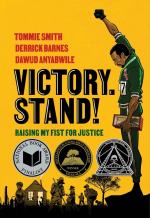|
This section contains 656 words (approx. 2 pages at 400 words per page) |

|
Victory. Stand! Summary & Study Guide Description
Victory. Stand! Summary & Study Guide includes comprehensive information and analysis to help you understand the book. This study guide contains the following sections:
This detailed literature summary also contains Topics for Discussion on Victory. Stand! by Dawud Anyabwile, Derrick Barnes, and Tommie Smith.
The following version of this book was used to create the guide: Smith, Tommie; Barnes, Derrick; Anyabwile, Dawud. Victory. Stand! Norton Young Readers, 2022.
Tommie Smith is born and spends his earliest years in Acworth, Texas. There, he lives in a simple house with his parents and his 11 siblings. Smith’s parents are sharecroppers, and the whole family works hard. His mother, Mulla, is said to be the center of the family. She instills a deep faith in Smith. The church the Smith family attends is near both the cemetery and the school, all three are only for Black people. Smith can go many days without seeing a white person, and it is hard for him to understand why white people seemingly have so much more than Black people do when God created everyone.
Slowly, Smith starts to realize that the family’s animals are disappearing. One day, the family is all loaded onto a bus. His parents have decided to move the family to California in the hopes of a better future. In California, the Smiths first live in a labor camp with other people who work to pay off their transportation to the state. While in Texas, the Smith children would frequently miss school to work. In California, all children are legally required to go to school. For the first time, Smith goes to a school that also has white children and is broken down by grade level. Smith comes to realize that the Black children are not often treated the same way the white children are. In the school, many teachers do not call on Black students and do not choose them for leadership positions. Smith’s father believes his children will have more opportunities than he did because they have the opportunity to receive an education.
Smith has always been fast, but his older sister Sally has always been faster. One day in PE class, Sally’s teacher asks her to go get Smith to race because she always wins her races against her classmates. Smith races Sally and an older boy and beats them both. This is just the beginning of Smith’s sports career. He starts playing and excelling at numerous sports. His father is okay with him participating in sports as long as he gets everything else done that he needs to. Still, his father is much more concerned with academics than with sports as he believes it is academics that will ultimately lead Smith out of poverty.
Smith receives numerous offers to compete in sports in college. Ultimately, he decides to attend San Jose State where he chooses to focus on track, competing with the college’s Speed City. Smith becomes one of the fastest people in the country. During his college years, his eyes are opened to racism around the country. He also comes to realize that because he has a platform as an athlete that he has a unique position to help the civil rights cause. Being an athlete does not make Smith immune to mistreatment because of his race, however. The college’s Black students cannot even find adequate housing.
Smith makes it to the Olympics. By this point, he has started to receive death threats because of his participation in the Civil Rights movement. He breaks the world record and wins the 200 meter race. When it is time for him to take the podium, he and John Carlos, the Black American bronze medal winner, put their gloved fists in the air rather than over their hearts. They do this because they do not believe it is right to salute the flag of a country that does not grant them equality. There is serious backlash over this, and they are not allowed to participate in the rest of the Olympics. Smith finishes his college degree and becomes a coach himself. He marries three times, and eventually he is inducted into the Hall of Fame.
Read more from the Study Guide
|
This section contains 656 words (approx. 2 pages at 400 words per page) |

|



